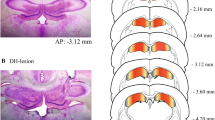Abstract
The influence of chronic destruction of the medial septal area (MSA) on focal potentials (FP) of field CA 1 evoked by stimulation of Schaffer collaterals was studied in experiments on viable sections of the the hippocampus of rats. The preparation, incubation, and pickup of FP of the sections of the control and experimental groups were carried out in identical conditions using traditional methods. The amplitude-temporal of population EPSP and population spikes, their interdependance, and their dependance on the strength of the stimulating current were assessed using automated data analysis. It was demonstrated that coagulation of the MSA is accompanied by an increase in the excitability of neuronal complexes of the lateral portion of field CA 1 which is manifested by the generation of multiple rhythmic discharges and the development of spike activity of the cells at a lower intensity of the synoptic inflow. It is hypothesized that destruction of the MSA leads to a relative attenuation of inhibitory control in the neuronal systems of field CA 1,the elements of which are depolarized with anomalous synchronicity and generate rhythmic impulse trains.
Similar content being viewed by others
Literature cited
N. P. Bekhtereva, D. K. Kambarova, and V. K. Pozdeev,The Stable Pathological State in Diseases of the Brain [in Russian], Meditsina, Moscow (1978).
S. L. Buldakova, A. A. Shandra, G. N. Kryzhanovskii, et al., “The characterization of the electrical activity of sections of the hippocampus of mice with corazole kindling,”Byull. Eksperim. Biologii,99, No. 3, 272–274 (1985).
O. S. Vinogradova, “Contemporary notions of the general properties and plastic phenomena in hippocampal neurons,”Uspekhi Fiziol, Nauk,15, No. 1, 28–54 (1984).
V. S. Vorob'ev and V. G. Skrebitskii, “The plastic properties of synapses in hippocampal sections,”Zhurn. Vyssh. Nervn. Deyat.,31, No. 2, 395–402 (1981).
V. F. Kichigina, “The functional characteristics of the association of Schaffer collaterals-field CA1 of the hippocampus in in vivo and in vitro experiments,”Neirofiziologiya,11, No. 3, 208–217 (1979).
G. N. Kryzhanovskii,Determinant Structures in the Pathology of the Nervous System [in Russian], Meditsina, Moscow (1980).
N. A. Otmakhov,Viable Brain Sections [in Russian], Pushchino (1987).
V. P. Podachin and B. M. Sidorov,Compensatory Processes in Limbic System Lesions [in Russian], Nauka, Moscow (1988).
B. M. Sidorov and V. D. Sosina, “Electrophysiological and behavioral changes following destruction of the basolateral nucleus of the amygdala in rats,”Zhurn. Vyssh. Nervn. Deyat.,36, No. 6, 1061–1068 (1986).
V. L. Silakov,The Regulation of the Central Mechanisms of Vision [in Russian], Nauka, Leningrad (1982).
F. Berton, R. Bianchi, W. Francsconi, et al., “Epileptiform discharge in rat hippocampal slices after chronic lesion of medial septal nuclei,”European J. Neurosci., Suppl. No. 2, 57 (1989).
G. Buzaki and F. H. Gage, “Absence of long-term potentiation in the subcortically deafferented dentate gyrus,”Brain Res.,484, No. 1–2, 94–101 (1989).
R. Dingledine, A. A. Roth, and G. L. King, “Synaptic control of pyramidal cell activation in the hippocampal slice preparation in the rat,”Neuroscience,22, No. 2, 553–561 (1987).
T. F. Freund and M. Antal, “GABA-containing neurons in the hippocampus,”Nature,336, No. 6195, 170–173 (1988).
J. G. R. Jefferys, “Chronic epileptic foci in vitro in hippocampal slices from rats with tetanus toxin epileptic syndrome,”J. Neurophysiol,54, No. 5, 1295–1304 (1985).
G. L. King, R. Dingledine, J. L. Giacchino, and J. O. McNamara, “Abnormal neuronal excitability in hippocampal slices from kindled rats,”J. Neurophysiol,62, No. 2, 458–468 (1989).
H. Oka and K. Yoshida, “Septohippocampal connections to field CA1 of the rat identified with field potential analysis and retrograde labeling by horseradish peroxidase,”Neurosci. Lett.,58, No. 1, 19–24 (1985).
L. W. Swanson and W. M. Gowan, “Autoradiographic studies of the development and connections of the septal area in the rat,”Advances Behav. Biol.,20, 37–64 (1976).
R. K. S. Wong, R. D. Traub, and R. Miles, “Epileptogenic mechanisms as revealed by studies of the hippocampal slice,” Academic Press, London (1984), pp. 253–275.
Author information
Authors and Affiliations
Additional information
Translated from Zhurnal Vysshei Nervnoi Deyatel'nosti imeni I. P. Pavlova, Vol. 41, No. 1, pp. 131–138, January–February, 1991.
Rights and permissions
About this article
Cite this article
Sidorov, B.M., Francesconi, V. & Berton, F. Change in neuronal excitability in hippocampal sections of rats isolated after the destruction of the medial septal area. Neurosci Behav Physiol 22, 39–44 (1992). https://doi.org/10.1007/BF01186666
Received:
Revised:
Issue Date:
DOI: https://doi.org/10.1007/BF01186666



